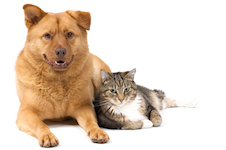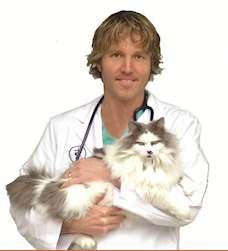|
 Hello Friend, Hello Friend,
A cheery Tuesday to you and the shedding members of your family.
Diseases, and Emergencies happen, yet you can do a lot in lowering your Veterinary Fees by being prepared and doing more at home.
My COMPLETE Manual gives you EVERYTHING you need to be ready:
http://www.veterinarysecretsrevealed.com
-------------------------------------------
The WHYS and WHAT of a Pet First Aid Kit
-------------------------------------------
Over nearly 20 years of Veterinary Practice, I have seen THOUSANDS
of pet Ailments that could have been treated at home- especially if
the owners had caught the problem EARLY, and used an EFFECTIVE Home
Remedy.
You should ALL have a basic First Aid Kit- so in the interest of helping your pet, and lowering your Veterinary Fees, here are my suggestions:
It is necessary to have a good first aid kit in order to be prepared for emergencies. There should be a first aid kit in your car, at your job site, and in your home. The more complete your first aid kits are, the better you can deal with emergencies when they happen. The best time to assemble those kits is now. If you wait until you are in an emergency situation, you will be too late.
The primary objectives of first aid are to relieve suffering, to save a life, and to prevent further physical or psychological injuries until you can reach or be reached by qualified health care personnel. These goals will help you assemble your first aid kits. Consider all of the possible emergencies that can happen.
First aid kits should be kept in containers that are labeled as such. Small containers that work well for first aid kits are cosmetic boxes, sewing boxes, tackle boxes, toolboxes, etc. If you purchase your supplies first, you will have a better idea what size box you will need.
Keep the box in a single location in your house, car, and workplace. Everyone should know where it is. If you are the injured party and unconscious, or if you are not present at the time of injury, the best first aid kit in the world will not help when no one can find it. It should be stored out of the reach of very young children and pets.
Here are some basic items that all first aid kits should contain:
1. Rectal thermometer: The newer electronic kind works best. The electronic ones beep when they are finished registering a temperature. They are slightly smaller than the glass kind. They do not break as easily. They can be covered with thin sleeves to halt the spread of germs. They can also be used as oral thermometers. They do have a battery that will need replacing, and they are more expensive then the glass ones.
2. Lubricating jelly: to lubricate the thermometer.
3. Gel packs: Can be used for hot and cold compresses.
4. Adhesive tape: to secure bandages, both nonstick tape and waterproof tape.
5. Blunt-tipped scissors: a must for animal first aid, used for cutting hair away from wounds.
6. Bandage scissors
7. Splints
8. Alcohol swabs: to sterilize instruments or small areas of skin.
9. Antibiotic ointment: for wounds (not for eyes), e.g. Polysporin; for non-puncture-type wounds.
10. Contact lens solution: for rinsing eyes, cleaning wounds (water can be substituted).
11. Cotton swabs: i.e., Q-tips.
12. Hibitane: a mild antibacterial soap for cleaning skin, wounds.
13. Sterile cotton or cotton balls
14. Sterile gauze pads: the larger four-inch size is better since it can easily be cut smaller if necessary.
15. Rolls of gauze or cling gauze bandage: one- to two-inch size.
16. Hydrogen peroxide: 10 ml every fifteen minutes to induce vomiting in animals that have ingested a noncaustic poison.
17. Razor blade: can also be used to shave away hair and abrade the skin following a tick bite.
18. Stockingette: to protect bandage on leg or foot.
19. Rubber bulb ear syringe: used for flushing eyes, ears, and wounds.
20. Forceps and/or tweezers
21. Self-adhesive bandage: i.e., Vetrap.
22. Numbers for the Animal Poison Hotline & Poison Control for Pets: (ASPCA: 888-426-4435 888-426-4435; Pet Poison Helpline: 800-213-6680 888-426-4435; Pet Poison Helpline: 800-213-6680 800-213-6680 (US and Canada); Animal Poison Control Center: 888-426-4435 800-213-6680 (US and Canada); Animal Poison Control Center: 888-426-4435 888-426-4435, numbers charge a fee). The National Poison Control Hotlines for humans should also be included. 888-426-4435, numbers charge a fee). The National Poison Control Hotlines for humans should also be included.
23. Information card with your veterinary emergency clinic number
24. Your pet’s baseline temperature, pulse, respirations and weight
25. A muzzle: or fabric to make one.
26. Bubble wrap: for making an emergency splint
P.S. To be fully prepared I advise starting with my Manual, Veterinary Secrets Revealed.
It covers the common dog and cat diseases and emergencies. You can get it here:
http://www.veterinarysecretsrevealed.com
Heal Your Pets At Home!
Best Wishes,
Dr Andrew Jones

DISCLAIMER: This information is for educational purposes only and is not intended to replace the advice of your own veterinarian. Dr Andrew Jones resigned from the College of Veterinarians of B.C. effective December 1 2010, meaning he cannot answer specific questions about your pet's medical issues or make specific medical recommendations for your pet.
PRIVACY POLICY: We will never rent, sell, loan, provide, barter, exchange or in any way make available your personal information to others. You can unsubscribe or change your email address at any time using the links at the bottom of this email.
Copyright 2014 Four Paws Online Ltd.
Tel: 1-800-396-1534 1-800-396-1534 1-800-396-1534
Fax: 1-888-398-1378
www.veterinarysecretsrevealed.com
support@veterinarysecretsrevealed.com
|